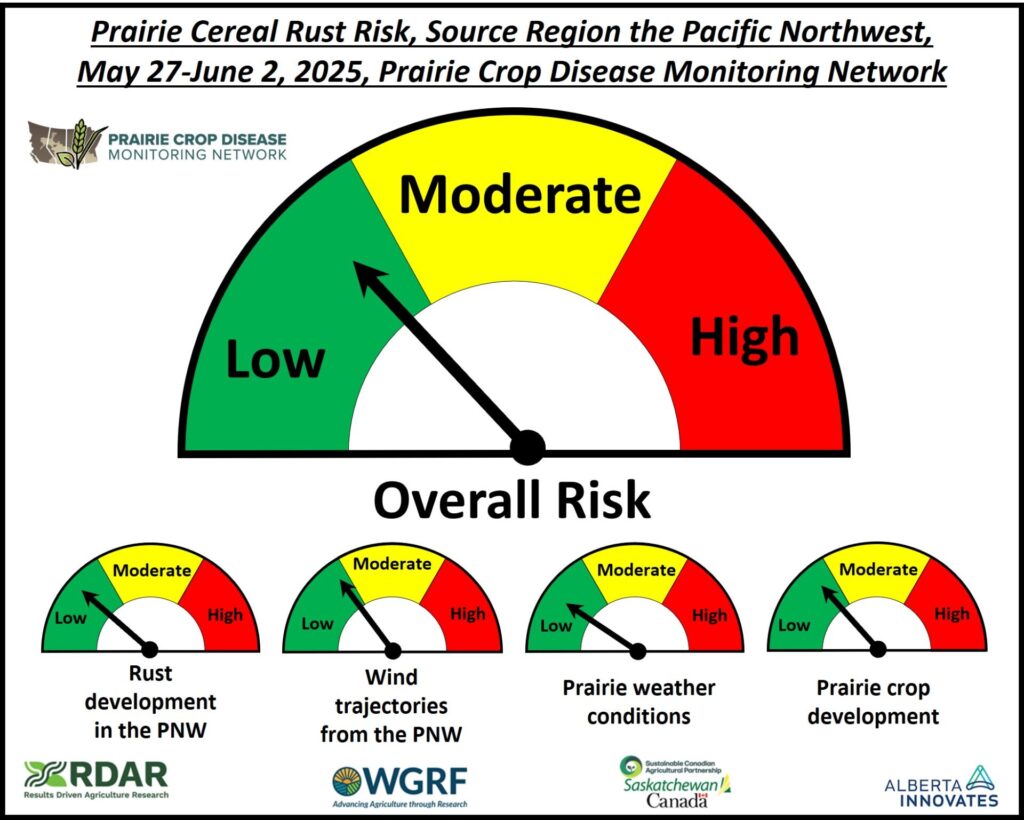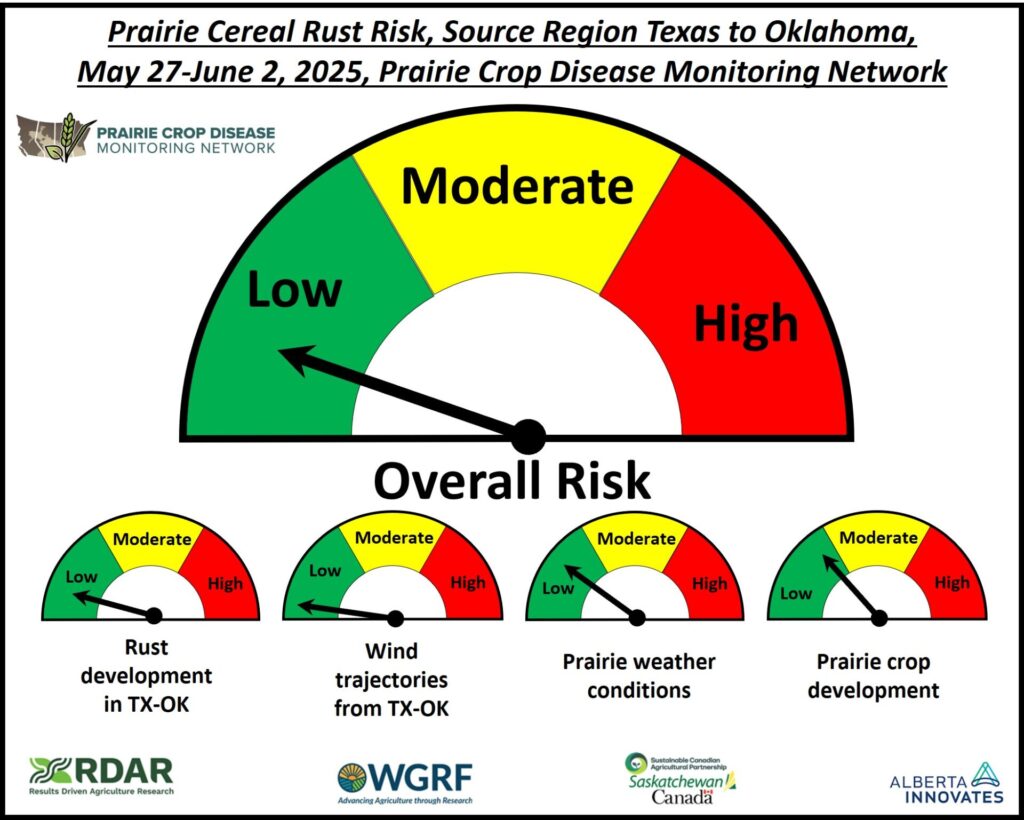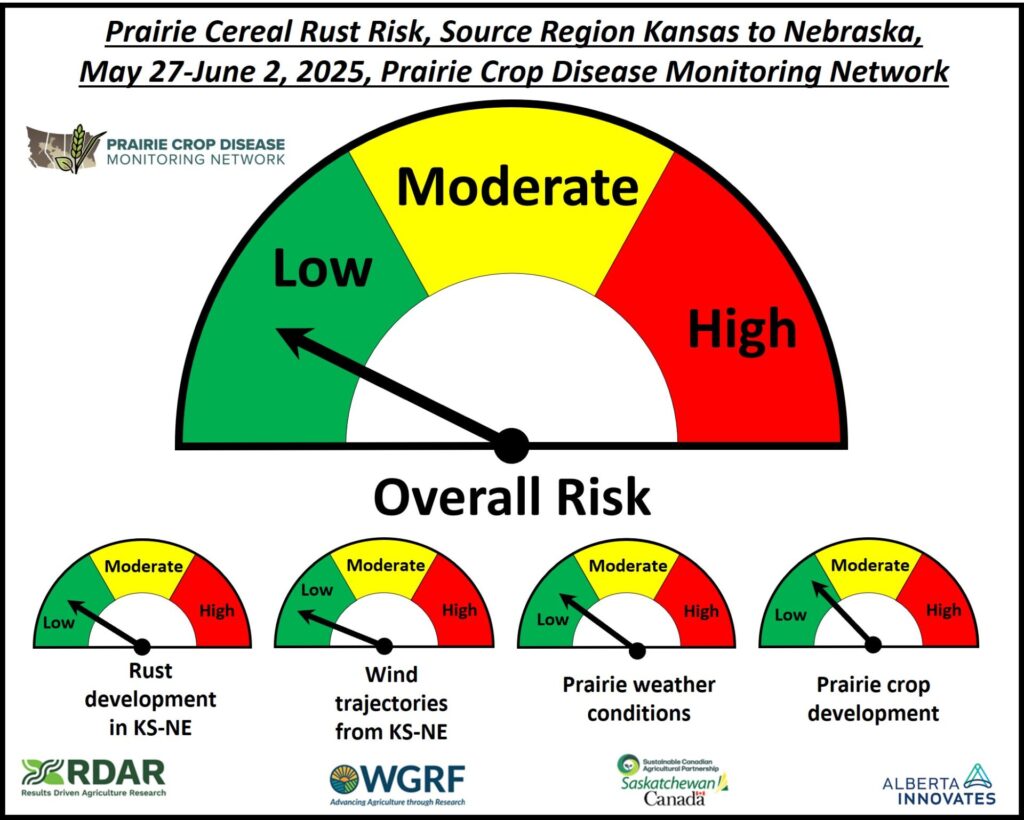The fourth weekly Prairie Crop Disease Monitoring Network (PCDMN) Prairie wind trajectory cereal rust risk report for 2025 is available for download now at the following link: May 27-June 2, 2025 report Pacific Northwest Texas-Oklahoma corridor Kansas-Nebraska corridor.
Please note that the previous third weekly Prairie Crop Disease Monitoring Network (PCDMN) Prairie wind trajectory cereal rust risk report for 2025 is currently being updated as there were some data processing issues in relation to the wind trajectories.
General weather and crop conditions
- Prairie winter wheat crops are generally in the flag leaf emergence to booting growth stages, while much of the spring wheat crop is now seeded with plants ranging from the seedling to 4-5 leaf stages, with tillering starting in some fields.
- Temperatures have been somewhat higher than normal for most of the Prairie region since April 1, 2025, and from May 25-June 1, 2025 temperatures have ranged from around 8.5 to 15.7°C.
- These temperatures are generally not conducive to rust development, although cooler temperatures are more conducive for stripe rust versus leaf and stem rust.
- Growing season rainfall for the Prairie region has been generally drier than normal.
- Recent rainfall in some areas the Prairies could potentially have washed rust spores from the air and into wheat crops, especially winter wheat, while also resulting in canopy moisture conditions that may favour infection and further rust development.
Pacific Northwest
- There were low-moderate numbers of reverse wind trajectories that passed over the PNW region and into the prairies from May 27-June 2, 2025.
- Although, stripe rust development continues, it is generally lower versus 2024; however, further development may occur over the next several weeks.
- Overall, as of June 5, 2025 the risk of stripe rust appearance from the PNW is generally limited and scouting for this disease in the Prairie region is generally not urgent
- However, there were 20 locations, mainly in Alberta and a few in Saskatchewan that had an elevated number of trajectories.
- Although the current stripe rust situation in the PNW is limited, Prairie farmers in these areas that are growing susceptible varieties may want to consider keeping an eye out for stripe rust symptoms as they visit fields for weed scouting and crop inspection activities.
- However, there were 20 locations, mainly in Alberta and a few in Saskatchewan that had an elevated number of trajectories.

Texas/Oklahoma
- There was only one reverse wind trajectory that passed over the TX/OK region and into the prairies from May 27-June 2, 2025, while development of stripe and leaf rust of wheat is generally limited.
- Moreover, most of the crop is likely mature, with harvest progressing.
- Overall, as of June 5, 2025 the risk of stem, leaf, stripe, and crown rust appearance from the Texas-Oklahoma corridor is limited and scouting for these diseases in the Prairie region is not urgent.

Kansas/Nebraska
- There was a relatively low number of wind trajectory events from the KS/NE region from May 27-June 2, 2025.
- Overall, as of June 5, 2025 the risk of stem, leaf, stripe, and crown rust appearance from the Kansas-Nebraska corridor is generally limited and scouting for these diseases in the Prairies is not urgent
- However, continuing rust (mainly stripe rust) observations and further development in KS/NE may increase the risk.
- From May 27-June 2, 2025, there were five locations in Alberta and Saskatchewan that had an elevated number of trajectories.
- Although the current rust situation in the KS/NE region is limited, Prairie farmers in these areas that are growing susceptible varieties may want to consider keeping an eye out for rust symptoms as they visit fields for weed scouting and crop inspection activities.


